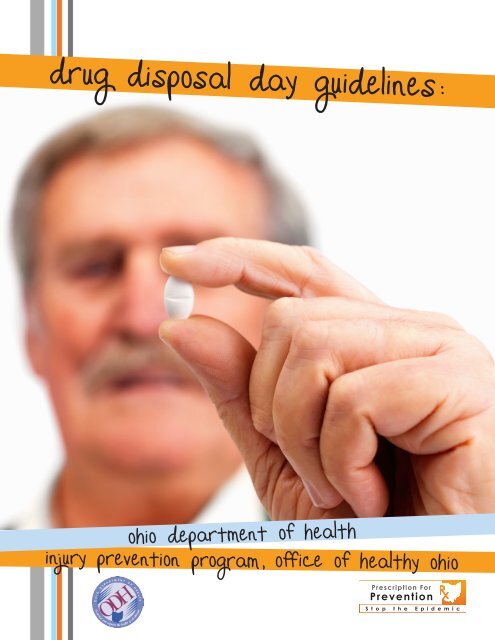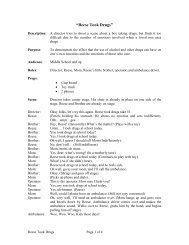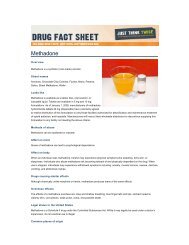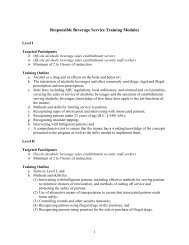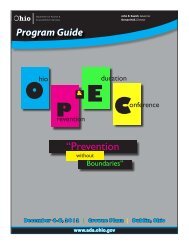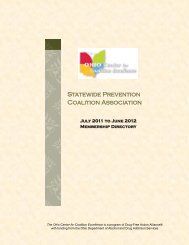ODH Drug Disposal Day Guidelines - Healthy Ohio - State of Ohio
ODH Drug Disposal Day Guidelines - Healthy Ohio - State of Ohio
ODH Drug Disposal Day Guidelines - Healthy Ohio - State of Ohio
You also want an ePaper? Increase the reach of your titles
YUMPU automatically turns print PDFs into web optimized ePapers that Google loves.
drug disposal day guidelines:<br />
ohio department <strong>of</strong> health<br />
injury prevention program, <strong>of</strong>fice <strong>of</strong> healthy ohio<br />
Prescription For<br />
Prevention<br />
S t o p t h e E p i d e m i c
table <strong>of</strong> contents<br />
Table <strong>of</strong> Contents<br />
Acknowledgements………………………………………………………………….…….page 1<br />
Introduction…………………………………………………………………………..……..page 2<br />
Overview…………………………………………………………………………….……...page 2<br />
Partners……………………………………………………………………………...Attachment 1<br />
• Suggested Organizations and Agencies<br />
• Responsibilities for Key Partners at the Event<br />
• Law Enforcement<br />
• Pharmacists<br />
• Hazardous Waste Company<br />
• Other Staff/ Volunteers<br />
Preparation Before the Event……………………………………………………....Attachment 2<br />
• Identify the Date, Time, and Location<br />
• Determine if Controlled and Non-controlled Substances will be Segregated<br />
• Accepted Items<br />
• Logistical Supplies for a Successful Event<br />
• How to Publicize your Event<br />
• Types <strong>of</strong> Educational Materials to Distribute<br />
• How to Develop and Distribute a Participant Survey<br />
Considerations……………………………………………………………………...Attachment 3<br />
• Privacy<br />
• Safety<br />
• Avoiding Illegal Diversion<br />
The Collection………………………………………………………………………Attachment 4<br />
Legal Strategy for Medication Collection<br />
• Inventory<br />
• Packing the Medications<br />
• Destruction<br />
After the Event…………………………………………………………………….Attachment 5<br />
• Data Analysis<br />
• Report the Results<br />
Examples <strong>of</strong> Event Advertisement…………………………...Attachment 6
acknowledgements<br />
<strong>Guidelines</strong> Developed by:<br />
• Amy Kuhn, Intern<br />
Injury Prevention Program, <strong>Ohio</strong> Department <strong>of</strong> Health<br />
Phone: 614-644-0204<br />
E-mail: amy.kuhn@odh.ohio.gov<br />
For More Information:<br />
• Christy Beeghly, MPH, Program Administrator<br />
Injury Prevention Program, <strong>Ohio</strong> Department <strong>of</strong> Health<br />
Phone: 614-728-4116<br />
E-mail: christy.beeghly@odh.ohio.gov<br />
• Judi Moseley, Program Consultant<br />
Injury Prevention Program, <strong>Ohio</strong> Department <strong>of</strong> Health<br />
Phone: 614-728-8016<br />
E-mail: judi.moseley@odh.ohio.gov<br />
Many Thanks to Everyone Who Developed and Reviewed this<br />
Document:<br />
• Lea Blackburn, Community Partnerships <strong>Ohio</strong>Health<br />
• Hancock County Community Partnership & ADAMHS Board<br />
• Karen Murray, Butler County Coalition, Butler County Alcohol and <strong>Drug</strong><br />
Addiction Services Board<br />
• Mike Puccini, The Kroger Company<br />
• Deborah H<strong>of</strong>fman, <strong>Ohio</strong> EPA<br />
• Fleishman-Hillard Inc.<br />
References:<br />
• <strong>State</strong> <strong>of</strong> <strong>Ohio</strong> Environmental Protection Agency. “Requirements for a<br />
Pharmaceutical Collection in <strong>Ohio</strong>”. <strong>Ohio</strong> EPA. September 2010. <br />
• Lynn Rubinstein. “Best Management Practices for Holding Unwanted<br />
Medication Collections: A Legal and Safe Approach for Community<br />
Pharmacies”. Northeast Recycling Council. November 2008. <br />
• Lynn Rubinstein. “Operating Unwanted Medication<br />
Collections: A Legal and Safe Approach”. Northeast<br />
Recycling Council. September 2006. <br />
page 1
Introduction and overview<br />
Introduction<br />
<strong>Drug</strong> <strong>Disposal</strong> <strong>Day</strong>s are implemented to ensure that unwanted medications are collected<br />
and destroyed using methods that are both legal and environmentally friendly. According<br />
to the 2007 National Survey on <strong>Drug</strong> Use and Health (NSDUH), a majority <strong>of</strong> individuals<br />
who used pain relievers non-medically in the past 12 months obtained the medication from<br />
a friend or family member for free. In addition, the 2007 <strong>Ohio</strong> Youth Risk Behavior Survey<br />
found that 26.5 percent <strong>of</strong> high school students reported using a prescription drug without<br />
a doctor’s prescription one or more times during their lifetime. Other studies show that<br />
teens most <strong>of</strong>ten obtain prescription drugs from friends and/or family members. Holding<br />
drug disposal events can help prevent medication diversion and raise public awareness.<br />
Pairing events with educational efforts is strongly encouraged. Keep in mind that events<br />
can range in size, from “two cops and a bucket” to a large scale community event. This<br />
document is a comprehensive guide, covering the logistical and legal matters involved<br />
in a large scale drug disposal event. Implementing a smaller scale event may not require<br />
covering all the steps outlined below.<br />
Overview<br />
1. Contact Local Partners (see Attachment 1)<br />
• Required:<br />
• Law enforcement must be present to take custody <strong>of</strong> the controlled medications.<br />
• Call or send a written request to your local law enforcement seeking their<br />
participation.<br />
• If controlled and non-controlled medications will not be segregated, then<br />
all must be treated as controlled substances. Law enforcement must have<br />
custody <strong>of</strong> controlled substances until destruction.<br />
• If it is determined that controlled and non-controlled medications will be<br />
segregated during the event, a pharmacist must be present to identify and<br />
segregate the medications.<br />
• USDEA permission is required if a pharmacist will be handling the collected<br />
medications.<br />
• It is not required that pharmacists participate. However, if pharmacists are not<br />
present to segregate controlled and non-controlled medications, all must be<br />
treated as controlled substances.<br />
• If it is determined that controlled and non-controlled medications will be<br />
segregated during the event, a hazardous waste company licensed with the<br />
<strong>Ohio</strong> <strong>State</strong> Board <strong>of</strong> Pharmacy as a Wholesale Distributor <strong>of</strong> Dangerous<br />
<strong>Drug</strong>s may be used to transport and destroy all non-controlled medication.<br />
• Identify an appropriate facility for proper destruction.<br />
• Event organizers or law enforcement may need assistance in locating an<br />
appropriate facility as listed in <strong>Ohio</strong> Environmental<br />
Protection Agency’s (EPA) guidance document (see<br />
References above).<br />
• In some cases, a hazardous waste company can be<br />
allowed by the U.S. <strong>Drug</strong> Enforcement Agency (DEA)<br />
page 2
Introduction and overview (con’t)<br />
to destroy the collected pharmaceuticals at the collection site and then<br />
transport them to another location for incineration.<br />
• Recommended:<br />
• Local organizations and agencies for support, sponsorship, and volunteers<br />
• Hospitals, pharmacies, health departments, substance abuse treatment<br />
centers, county medical societies, etc.<br />
• Other staff<br />
• Site supervisor, greeters, data entry, pharmacy technicians, and interns<br />
2. Obtain Permits and Approval<br />
• A letter to local/regional DEA agent-in-charge seeking written approval is required.<br />
It should be sent by the local police department involved and should include the<br />
following:<br />
• Date, time, and location<br />
• Description <strong>of</strong> participating law enforcement<br />
• Detailed description <strong>of</strong> the event, including the disposal method<br />
• Whether controlled and non-controlled medications will be segregated by a<br />
pharmacist<br />
• It is not required to notify the <strong>Ohio</strong> EPA.<br />
• It is not required to notify the <strong>Ohio</strong> <strong>State</strong> Board <strong>of</strong> Pharmacy; however, notification<br />
may be helpful so they can refer consumers.<br />
3. Preparation before the Event (see Attachment 2)<br />
• Identify the date, time, and location.<br />
• Determine whether controlled and non-controlled substances will be segregated.<br />
• Determine what materials will be collected.<br />
• Determine responsibilities for each partner.<br />
• Prepare and distribute publicity and educational materials.<br />
• Prepare and distribute a participant survey (optional, but recommended).<br />
• Provide necessary supplies.<br />
4. Considerations (see Attachment 3)<br />
• Patient privacy<br />
• Safety<br />
• Avoiding medication diversion<br />
5. The Collection (see Attachment 4)<br />
• Legal strategy for medication collection<br />
• Medication inventory<br />
• Packing medications<br />
• Destruction<br />
6. After the Event (see Attachment 5)<br />
• Analyze the participant surveys and the medication inventory.<br />
• Report the results to the community and event partners.<br />
page 3
attachment 1: partners and responsibilities<br />
Suggested Organizations and Agencies<br />
• Below are the suggested organizations and agencies to contact for financial and<br />
logistical support <strong>of</strong> the event.<br />
• Ideally, all partners should assist with planning, publicity, and providing volunteers for the<br />
event. Prepare publicity materials and supply to partners for distribution.<br />
• Local health departments<br />
• Nursing associations<br />
• County medical society<br />
• County fire departments<br />
• County sheriff’s <strong>of</strong>fices<br />
• Solid Waste Management Districts (SWMDs)<br />
• County/city departments on aging<br />
• Centers for Medicare & Medicaid Services<br />
• <strong>Drug</strong>-free community coalitions<br />
• Hospitals<br />
• Hospices<br />
• Pharmacies<br />
• Public and private universities<br />
• Poison control centers<br />
• Religious groups<br />
• <strong>Ohio</strong> <strong>State</strong> Board <strong>of</strong> Pharmacy<br />
• <strong>Ohio</strong> Dental Association<br />
• <strong>Ohio</strong> Environmental Protection Agency<br />
• <strong>Ohio</strong> Department <strong>of</strong> Health<br />
• <strong>Ohio</strong> Public Works Commission<br />
• Local <strong>of</strong>fice <strong>of</strong> US <strong>Drug</strong> Enforcement Agency<br />
• <strong>State</strong> TRIAD agencies<br />
• Substance abuse treatment centers<br />
• Alcohol and substance abuse boards<br />
• Veterans administration hospitals<br />
• Veterinary organizations/hospitals<br />
• Wastewater treatment plants<br />
• Soil and water conservation districts<br />
Responsibilities for Key Partners at the Event<br />
Law Enforcement<br />
• Send a letter to the local DEA agent-in-charge requesting approval for the event.<br />
• Take custody <strong>of</strong> controlled substances; by law, law enforcement are the only people who<br />
can be in possession <strong>of</strong> the collected medications.<br />
• Note: If pharmacists are not present at the event to segregate<br />
controlled and non-controlled medications, all medications are<br />
treated as controlled substances.<br />
• Determine what containers the controlled substances will be<br />
deposited in.<br />
• Most likely, your local law enforcement will have a disposal<br />
page 4
attachment 1: partners and responsibilities (con’t)<br />
method already in place. Therefore, they may provide the disposal containers for<br />
controlled substances. However, prior to the event be sure to establish who is<br />
responsible for supplying the containers.<br />
• Transport the medication directly to the site <strong>of</strong> destruction or transport controlled<br />
substances to the agency’s evidence locker and maintain secured locked possession.<br />
• Take responsibility for disposal <strong>of</strong> controlled substances.<br />
• Prevent medication diversion by carefully witnessing all stages <strong>of</strong> the collection process.<br />
Pharmacist<br />
• Segregate controlled and non-controlled substances.<br />
• Identify unlabeled medications using reference materials as necessary.<br />
• Inventory the medications (optional).<br />
• Instruct law enforcement to take possession <strong>of</strong> controlled substances.<br />
• Provide counting materials and reference materials for identifying medications.<br />
Hazardous Waste Company (HWC)<br />
• Transport and destroy all non-controlled medications.<br />
• Law enforcement may have the resources and opt to handle the non-controlled<br />
medications along with the controlled substances. Consult with the local law<br />
enforcement involved to determine if this is a possibility for your event.<br />
• In some instances, a hazardous waste company may be authorized by US DEA to<br />
destroy medications on-site.<br />
• Provide disposal containers for non-controlled substances.<br />
• Seal the filled containers and transport the non-controlled substances to point <strong>of</strong><br />
destruction.<br />
• Properly destroy the collected medications.<br />
• Provide a certificate <strong>of</strong> destruction.<br />
• Tips on choosing a HWC:<br />
• Check with <strong>Ohio</strong> EPA Division <strong>of</strong> Hazardous Waste Management. A list <strong>of</strong><br />
companies can be found at: epawebapps.epa.state.oh.us/Recyclers/jsp/results.<br />
jsp?category=29<br />
• Seek recommendations <strong>of</strong> a company used in past events.<br />
• Verify that the company is properly permitted to accept and transport<br />
pharmaceuticals.<br />
• A contract, pricing, and the delivery <strong>of</strong> containers should be negotiated by the event<br />
organizer.<br />
• Know if the company has requirements for segregating medications, such as<br />
separating items under pressure, needle delivery medications, nitrogen based<br />
medications, and mercury containing medications.<br />
Other Staff/ Volunteers<br />
Prior to the event, recruit staff/volunteers and assign them to serve in<br />
the following roles:<br />
• Site Supervisor<br />
• Coordinate site set up.<br />
page 5
attachment 1: partners (con’t)<br />
• Direct staff and volunteers.<br />
• Oversee the collection process to ensure proper procedure is followed.<br />
• Maintain copies <strong>of</strong> the medication inventory (inventory is optional).<br />
• Verify that the medication has been properly disposed <strong>of</strong> by the HWC.<br />
• Data Entry<br />
• Record inventory <strong>of</strong> medications (inventory is optional).<br />
• Greeter<br />
• Give direction to participants and answer questions.<br />
• Provide pens/markers to obscure personal information.<br />
• Distribute educational materials.<br />
• Survey participants.<br />
• Pharmacy Interns and Technicians<br />
• Assist the pharmacist(s) in identifying and counting medications<br />
• Be sure that permission has been granted by the USDEA for these individuals to<br />
handle medications.<br />
page 6
attachment 2: preparation before the event<br />
Identify the Date, Time, and Location<br />
• For a large scale event with multiple locations, preparations should begin at least 90<br />
days before the event. Smaller events or one location events may need less preparation<br />
time.<br />
• The day and time should be convenient for participants. Hold the event on the weekend<br />
beginning in the morning and ending in late afternoon (e.g., 9 a.m.-3 p.m.).<br />
• Choose a neutral, easily accessible location with free parking.<br />
• The logistics <strong>of</strong> the site should include barriers/protection around the drug handling area.<br />
• If an outdoor site is chosen, consider shelter from inclement weather (such as tents or<br />
canopies).<br />
• Make sure event volunteers and <strong>of</strong>ficers will have easy access to restrooms.<br />
Determine if Controlled and Non-controlled Substances will be Segregated<br />
There are two options for the collection and disposal <strong>of</strong> the medications:\<br />
1. No segregation <strong>of</strong> controlled and non-controlled medication.<br />
• If medications will not be segregated then ALL medications must be treated as<br />
controlled substances.<br />
• Pharmacists are not required for this method.<br />
• Law enforcement <strong>of</strong>ficers take possession <strong>of</strong> ALL medications and assume<br />
responsibility for their destruction.<br />
2. Segregation <strong>of</strong> controlled and non-controlled medication (must be approved by USDEA<br />
• Pharmacists determine whether medication is controlled or non-controlled.<br />
• Controlled substances are taken into custody by law enforcement.<br />
• Non-controlled substances are deposited into the hazardous waste containers for<br />
removal by the HWC.<br />
• Medications that cannot be identified are treated as controlled substances.<br />
Accepted Items<br />
• It is important to determine what items will and will not be accepted at the event.<br />
• The following items should be considered: Over-the-counter (OTC) medications,<br />
veterinary medications, vitamins, supplements, thermometers, and sharps (needles).<br />
• A note on sharps and thermometers:<br />
• Have sharps containers and thermometer containers available.<br />
• Even if it is determined that sharps and/or thermometers will not be collected, it is<br />
inevitable that participants will bring them. Be prepared to collect these items either<br />
way.<br />
• Contact your local hospital or solid waste management district for assistance with<br />
disposal <strong>of</strong> sharps.<br />
• Contact a local mercury recycling service or your local solid waste management<br />
district for disposal <strong>of</strong> thermometers. Additionally, you might want to contact <strong>Ohio</strong><br />
EPA for assistance.<br />
Logistical Supplies for a Successful Event<br />
Site Set-up<br />
• Tables and chairs<br />
• Tents/canopies (if outdoor site is chosen)<br />
• Traffic cones<br />
page 7
attachment 2: preparation before the event (con’t)<br />
• Caution tape (to define restricted areas)<br />
Signage<br />
• Signage specifying the work stations<br />
• Signage to direct participants<br />
• Educational displays<br />
• Display boards and easels<br />
Collection Supplies<br />
• Recycling bins for excess medication packaging, pill containers, etc. Contact your local<br />
solid waste management district to learn more about recycling options.<br />
• Plastic containers to secure medications for destruction (containers for non-controlled<br />
medications may be provided by the HWC).<br />
• Sealable plastic bags<br />
• Containers specified for sharps (obtain from a local nursing home, hospital, or fire<br />
department)<br />
• Containers specified for thermometers<br />
• Pill counters for the pharmacist (if conducting an inventory)<br />
• Packing tape<br />
• Permanent markers to blackout information on prescription bottles<br />
• Inventory sheets<br />
• Copies <strong>of</strong> participant survey<br />
• Educational handouts<br />
• Scissors<br />
• Pencils and pens<br />
• Clipboards<br />
• Note pads/paper<br />
Supplies for Staff/Volunteers<br />
• Name tags<br />
• Safety vests for those directing traffic<br />
• Protective gloves and masks for law enforcement and pharmacists<br />
• Hand sanitizer<br />
• Snacks and refreshments<br />
Equipment<br />
• Computer with a spreadsheet template to record inventory<br />
• Printer to print the inventory<br />
How to Publicize your Event<br />
• Create a press release to be distributed to local media and posted on internet websites.<br />
• Create flyers (electronic and printed) and send to organizations for display and/or<br />
distribution.<br />
• Send event information via email lists to hospitals, medical and<br />
nursing associations, nursing homes, local law enforcement<br />
agencies, prosecutors’ <strong>of</strong>fices, pharmacies, etc.<br />
• Supply area pharmacies with fliers to distribute to customers.<br />
• Create simple and visible signs to direct participants the day <strong>of</strong> the<br />
event.<br />
page 8
attachment 2: preparation before the event (con’t)<br />
• Create educational displays for day <strong>of</strong> the event (e.g., on foam board and easels).<br />
• Include the following important information in promotional materials (see Attachment 6<br />
for examples):<br />
• Date, time, and location<br />
• No cost to participate<br />
• Person or website to contact for more information<br />
• Total anonymity, no questions asked<br />
• Do not remove medication labels; cross out personal information but keep<br />
medication information legible<br />
• List <strong>of</strong> accepted and unaccepted items: OTC, pet medications, vitamins,<br />
supplements, thermometers, sharps, medical waste, aerosol cans, etc.<br />
• Medications will not be returned and refunds will not be given.<br />
• Medications will be destroyed, not resold or reused.<br />
Types <strong>of</strong> Educational Materials to Distribute<br />
• Prescription drug use fact sheets<br />
• Talking points for parents<br />
• Information about proper disposal and safe usage <strong>of</strong> medication, including:<br />
• Flushing unwanted or left over medications down the drain/toilet can adversely affect<br />
the environment.<br />
• If a drug take back event is not available in your area, follow these steps to dispose<br />
<strong>of</strong> medications:<br />
1. Take the medications out <strong>of</strong> their original containers.<br />
2. Mix the medication with an undesirable substance.<br />
3. Put the mixture into a container, seal it, and put it in the trash.<br />
4. Mark out or remove any personal information, including the Rx number, from the<br />
empty medication container and discard it.<br />
• Never give your medications to someone else to take.<br />
• Never take a prescription that is not prescribed to you.<br />
• Keeping unwanted, left over, or expired medication in the home presents a danger to<br />
children, pets, and visitors who could ingest them.<br />
How to Develop and Distribute a Participant Survey<br />
• DO NOT ask for names<br />
• Hand out a printed survey or conduct a verbal survey<br />
• Possible questions:<br />
• City the participants live in<br />
• How the participants heard about the program<br />
• Newspaper, television, internet, e-mail, friend, pharmacy, radio, work, etc.<br />
• What types <strong>of</strong> medication the participants discarded<br />
• Pain, heart/blood pressure, antibiotic, asthma, antidepressant,<br />
cholesterol, veterinary, OTC, anti-nausea, cancer, allergy, etc.<br />
page 9
attachment 3: considerations<br />
What to Remember During the Event:<br />
• Comply with federal and state laws.<br />
• Privacy: Instruct participants to mark out all personal information on medications, but<br />
keep medication information (type, dosage) legible.<br />
• Safety:<br />
• Use universal precautions; all those who handle medications or come into contact<br />
with the disposal containers should wear gloves. Facemasks are encouraged,<br />
especially for those conducting a physical inventory.<br />
• It is not required by law that medications be kept in their original containers.<br />
However, doing so can help to minimize worker exposure and ensure public safety.<br />
• If it is decided that medications will be dumped out <strong>of</strong> their original containers,<br />
consider recycling the medication bottles.<br />
• Avoid illegal diversion <strong>of</strong> medications by strategically setting up the site and placing law<br />
enforcement appropriately.<br />
• Law enforcement should have visual contact with the people dropping <strong>of</strong>f the<br />
medications and the point <strong>of</strong> drop-<strong>of</strong>f.<br />
• Law enforcement should watch all movement <strong>of</strong> medication. For example, if<br />
event workers move medications from consumers’ cars to the sorting area, law<br />
enforcement should witness this process.<br />
• Protective barriers should be placed around the drug handling area. Individuals,<br />
including event volunteers, not authorized to handle the medications should not enter<br />
the drug handling area. Use caution tape to indicate restricted areas.<br />
• A law enforcement <strong>of</strong>ficer should be assigned the sole duty <strong>of</strong> monitoring the<br />
drug handling area to enforce restricted access.<br />
• When a medication is classified as a controlled substance, law enforcement must<br />
continue to monitor the medication.<br />
• The law enforcement agency involved should be given the full responsibility for the final<br />
say on the handling <strong>of</strong> the event. If questions or conflicting opinions arise during the<br />
planning stages or the actual event, it is better to lean toward more documentation and<br />
more safety.<br />
page 10
attachment 4: the collection<br />
Legal Strategy for Medication Collection:<br />
Note: The content below is based on information from the <strong>Ohio</strong> EPA, individuals who have<br />
experience implementing drug disposal events in <strong>Ohio</strong>, and publications from the Northeast<br />
Recycling Council.<br />
There are two options for the collection and disposal <strong>of</strong> medications:<br />
1. No segregation <strong>of</strong> controlled and non-controlled medication<br />
• If medications will not be segregated then ALL medications must be treated as<br />
controlled substances.<br />
• Pharmacists are not required for this method.<br />
• Law enforcement <strong>of</strong>ficers take possession <strong>of</strong> all medications and are responsible for<br />
their destruction.<br />
• This is <strong>of</strong>ten the preferred method because the medications are only handled by<br />
law enforcement. In general, the fewer individuals who handle the medications, the<br />
better.<br />
2. Segregation <strong>of</strong> controlled and non-controlled medication<br />
• Pharmacists determine whether medications are controlled or not.<br />
• Controlled substances are taken into custody by law enforcement.<br />
• Non-controlled substances are deposited into the hazardous waste containers for<br />
removal by the HWC.<br />
• Medications that cannot be identified are treated as controlled substances.<br />
Inventory<br />
• It is not required by law to inventory the collected medications. However, it may be<br />
required by the hazardous waste hauler.<br />
• Know what type <strong>of</strong> inventory is required by the company (i.e., only the weight <strong>of</strong> the<br />
containers or specific content).<br />
• Even though inventory <strong>of</strong> medications is not required, keeping track <strong>of</strong> at least the<br />
volume <strong>of</strong> materials shipped can help plan for future events.<br />
• For an item by item inventory, data entry staff should record the name, dosage, amount,<br />
and form <strong>of</strong> the medication.<br />
• Recording the weight and volume <strong>of</strong> collected medications is recommended, especially<br />
if medication is not individually inventoried.<br />
Packing the Medications<br />
• Non-controlled<br />
• Non-controlled medications go into the hazardous waste containers.<br />
• If required by the HWC, segregate medications into specified hazardous<br />
waste containers, such as separating items under pressure, needle delivery<br />
medications, nitrogen based medications, mercury containing<br />
medications.<br />
• If required by the HWC, place medication that comes without its<br />
original container in its own container (e.g., sealable plastic bag)<br />
and label it with name and dosage.<br />
• Unnecessary packaging may be removed to save space.<br />
page 11
attachment 4: the collection (con’t)<br />
• Place liquids and solids in separate containers if directed by the HWC.<br />
• Place sharps and thermometers in appropriate disposal containers.<br />
• Controlled<br />
• Place the medications in the containers reserved for controlled substances. The type<br />
<strong>of</strong> container used for controlled substances is up to the law enforcement disposing<br />
<strong>of</strong> the materials (e.g., sealable plastic bags, covered plastic pails, paper bags).<br />
• Medication that comes without its original container should be placed with controlled<br />
substances.<br />
• Place liquids and solids in separate containers.<br />
Destruction<br />
• If this method is selected, at the end <strong>of</strong> the event, the HWC removes the non-controlled<br />
medication and transports it to the point <strong>of</strong> destruction. In some cases, hazardous<br />
waste companies have been permitted to destroy controlled pharmaceuticals at<br />
the collection site, by dissolution or another similar process. This requires US DEA<br />
permission.<br />
• The site supervisor should follow up with the hazardous waste company to verify that the<br />
non-controlled medications have been properly destroyed.<br />
• Law enforcement transports the collected medications either directly to the destruction<br />
site or to the station’s property/evidence room and stores it until the time <strong>of</strong> destruction.<br />
• All the controlled substances are eventually transported by the law enforcement to the<br />
site <strong>of</strong> destruction. See <strong>Ohio</strong> EPA guidance document for more information.<br />
page 12
attachment 5: after the event<br />
Data Analysis<br />
• Data analysis can help plan and budget future events.<br />
• Medication inventory<br />
• If an inventory <strong>of</strong> individual medications was conducted, categorize it to see what the<br />
types <strong>of</strong> medication were collected.<br />
• Pain, heart/blood pressure, antibiotic, asthma, antidepressant, cholesterol,<br />
veterinary, OTC, anti-nausea, cancer, diabetes, allergy, etc.<br />
• Collect data on the weight and volume <strong>of</strong> material shipped for both controlled and<br />
non-controlled substances.<br />
• Determine the average amount <strong>of</strong> material brought in per person.<br />
• Participant surveys<br />
• Determine what advertising strategies worked.<br />
• Track the number <strong>of</strong> people who bring medication.<br />
• Learn what types <strong>of</strong> medication were more commonly collected from participants.<br />
• Learn if there is a need for events in surrounding communities.<br />
Report the Results<br />
• Inform event partners and the community about the success <strong>of</strong> the event.<br />
• Send a letter to event partners and volunteers.<br />
• Develop a press release for local media.<br />
page 13
attachment 6: examples <strong>of</strong> event advertisement
attachment 6: examples <strong>of</strong> event advertisement (con’t)
attachment 6: examples <strong>of</strong> event advertisement (con’t)
attachment 6: examples <strong>of</strong> event advertisement (con’t)


